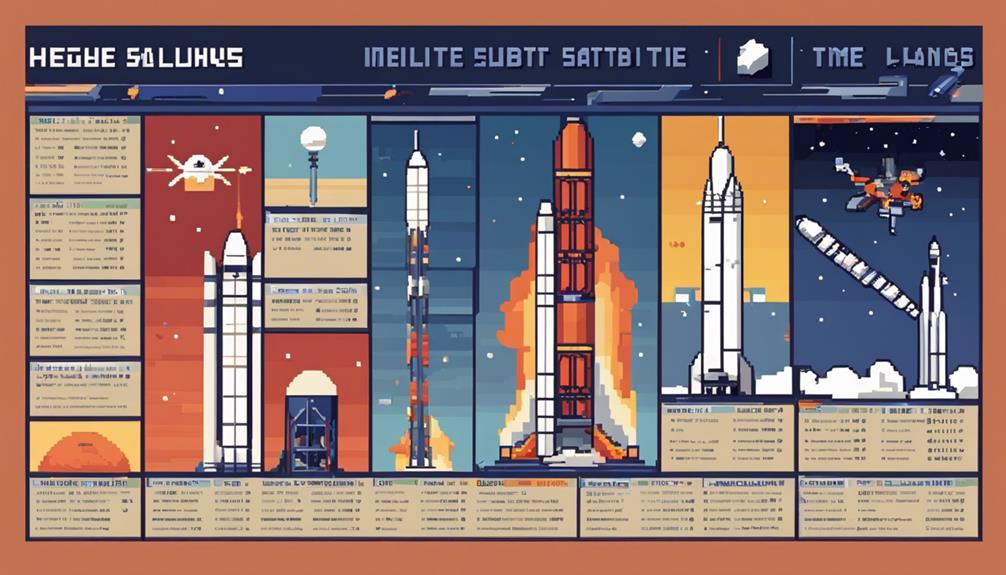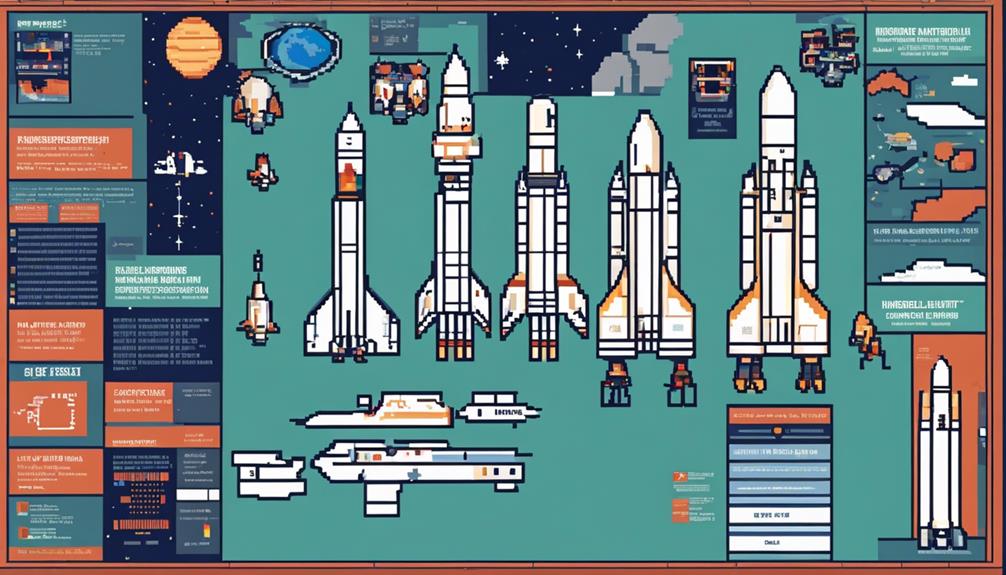The evolution of SpaceX's satellite launch endeavors has been punctuated by notable achievements, each underscoring the company's prowess in advancing space technology. From the deployment of the groundbreaking Starlink constellation to the revolutionary developments in rocket reusability, SpaceX has consistently pushed the boundaries of what is achievable in the realm of satellite launches. As we delve into the key milestones that have shaped SpaceX's satellite launch history, a narrative emerges that not only highlights the company's technical acumen but also hints at the transformative potential these advancements hold for the future of global connectivity and space exploration.
Key Takeaways
- SpaceX's launch failures drove innovation and improvements in engineering processes.
- Dragon spacecraft's docking at the ISS showcased private spacecraft reliability.
- Falcon 9 booster recovery innovations significantly lowered launch costs.
- SpaceX's booster recovery success rate exceeding 90% revolutionized spaceflight cost-efficiency.
Inaugural Falcon 1 Launch

The inaugural Falcon 1 launch conducted by SpaceX on March 24, 2006, encountered a critical failure attributed to a fuel leak, resulting in the loss of the vehicle. This event marked a significant milestone for SpaceX as it represented the company's first attempt at achieving orbit with their privately developed liquid-fuel rocket. The failure of this initial launch was a challenging setback for SpaceX; however, it provided crucial insights and learnings that would prove invaluable for their future endeavors in space exploration.
The unsuccessful Falcon 1 launch highlighted the complexities and risks involved in space missions, especially when introducing new technology and pushing the boundaries of innovation. Despite the disappointment of the loss, SpaceX was able to leverage this experience to enhance their engineering processes, improve quality control measures, and strengthen their overall mission planning.
The first launch of the Falcon 1 not only demonstrated the ambitious goals set by SpaceX but also laid the foundation for the company's relentless pursuit of advancing space travel and satellite launch capabilities. It served as a catalyst for SpaceX's determination to innovate, adapt, and ultimately succeed in the highly competitive aerospace industry. Through perseverance and a commitment to excellence, SpaceX continued to make significant strides in the field of space exploration following this initial setback.
Dragon Spacecraft's ISS Mission
Following the inaugural Falcon 1 launch setback in 2006, SpaceX's subsequent achievement with the Dragon spacecraft's ISS mission in 2012 marked a significant milestone in private space exploration. The Dragon spacecraft made history by becoming the first private spacecraft to successfully dock at the International Space Station (ISS). This accomplishment demonstrated SpaceX's capability to deliver cargo to the ISS, showcasing the reliability and versatility of private spacecraft in supporting space missions.
The critical role of the Dragon spacecraft in resupply missions to the ISS was further exemplified through its crewless capsule mission in 2017. SpaceX's advancements with the Dragon capsule have not only enabled successful cargo deliveries but have also laid the groundwork for potential crewed missions to the ISS, expanding the horizon of private space exploration.
The successful missions of the Dragon spacecraft to the ISS have not only highlighted SpaceX's reliability but also its significant contribution to advancing commercial spaceflight and logistics. The innovative technology and capabilities integrated into the Dragon spacecraft have propelled the field of private spacecraft towards more sophisticated and efficient operations in supporting missions to the International Space Station.
Successful Rocket Booster Recovery

SpaceX has continuously pushed the boundaries of rocket booster recovery, with milestones including the first successful landing in 2015 and the reuse of a Falcon 9 booster in 2017. These achievements have not only showcased the company's technological prowess but have also significantly reduced launch costs by enabling reusability. The introduction of autonomous drone ships for precise sea landings and the utilization of ships like Ms. Tree and Ms. Chief for fairing recovery further emphasize SpaceX's commitment to revolutionizing space travel through innovative recovery methods.
Booster Landing Innovations
Pioneering the realm of rocket recovery technology, SpaceX achieved a groundbreaking milestone in 2015 with the successful landing of a Falcon 9 first stage booster. Introducing innovative approaches, SpaceX utilized autonomous drone ships, such as 'Of Course I Still Love You' and 'Just Read the Instructions', to facilitate booster recovery. These advancements have not only enabled the company to reuse a Falcon 9 booster in 2017 but have also revolutionized the rocket recovery process. By focusing on rocket booster landing innovations, SpaceX has significantly reduced launch costs and increased operational efficiency. This strategic shift towards full reusability across all rockets underscores SpaceX's commitment to pushing the boundaries of space technology and exploration.
Recovery Success Rates
With a remarkable success rate exceeding 90%, SpaceX has demonstrated unparalleled proficiency in recovering rocket boosters, a feat that has significantly transformed the landscape of spaceflight economics. By landing Falcon 9 boosters on drone ships and on land, SpaceX has showcased its dedication to enhancing recovery success rates and advancing reusability efforts. The company's continuous improvement in recovering boosters with each mission highlights their commitment to innovation and cost-efficiency in spaceflight. Successful booster recoveries not only demonstrate SpaceX's technical prowess but have also led to a substantial reduction in launch costs, making space more accessible and economically viable. SpaceX's achievements in rocket booster recovery underscore their position as a leader in revolutionizing the dynamics of space exploration.
First Drone Ship Landing
The first successful drone ship landing by SpaceX on April 8, 2016, marked a major milestone in the company's pursuit of reusable rocket technology. This achievement showcased SpaceX's ability to precisely land and recover rocket boosters at sea, expanding the possibilities for cost-effective space missions. The utilization of drone ships like 'Of Course I Still Love You' in the Atlantic Ocean demonstrated SpaceX's commitment to innovation and sustainability in the aerospace industry.
Historic Drone Ship Landing
In 2016, SpaceX achieved a significant milestone in its reusability efforts with the historic drone ship landing, marking the first successful sea landing for the company. Following the launch of a Falcon 9 rocket, this event showcased SpaceX's commitment to reusability. The drone ship, named 'Of Course I Still Love You,' played a pivotal role in facilitating rocket recoveries at sea, proving crucial for future missions. By mastering sea landings, SpaceX demonstrated its progress towards sustainable and cost-effective launch capabilities. This achievement not only highlighted the company's technological advancements but also set the stage for further developments in rocket recoveries and reusability, solidifying SpaceX's position as a frontrunner in the aerospace industry.
Technological Advancement Achieved
Demonstrating a groundbreaking leap in rocket reusability, SpaceX achieved a pivotal milestone with its first successful drone ship landing in 2016. This technological advancement showcased the capability of recovering and reusing rocket boosters at sea, signifying a significant reduction in costs and enabling a higher frequency of launches. The drone ship, 'Of Course I Still Love You,' played a crucial role in facilitating safe rocket landings for refurbishment and subsequent relaunch. By successfully landing on the drone ship, SpaceX laid the foundation for revolutionizing the space industry through the practical implementation of reusable rockets. This achievement, coupled with the use of autonomous drone ships for rocket landings, has become a standard practice in SpaceX's launch operations, contributing to the efficiency and cost-effectiveness of space missions.
Historic Rocket Reusability Achievement

Pioneering a new era in space exploration, SpaceX achieved a historic milestone in rocket reusability with the first successful landing of a Falcon 9 booster in 2015. This achievement marked a significant breakthrough in reducing space travel costs by enabling the refurbishment and reuse of major components of the Falcon 9 rocket. By mastering the art of landing these boosters safely back on Earth, SpaceX demonstrated the potential for cost-effective space missions.
Let's take a closer look at the impact of SpaceX's historic rocket reusability achievement through the table below:
| Key Points | Details |
|---|---|
| First Successful Landing | Falcon 9 booster landed back on Earth in 2015, setting the stage for reusable rocket technology. |
| Cost Reduction | Reusing a Falcon 9 booster in 2017 showcased a significant step towards reducing space travel costs. |
| Enhanced Efficiency | Precision landing capabilities and drone ships improved rocket recovery methods, enhancing reusability prospects. |
SpaceX's relentless pursuit of full reusability across all its rockets has not only revolutionized rocket recovery methods but has also led to a substantial decrease in launch costs, making space travel more economically viable and efficient.
Starlink Satellite Deployment
SpaceX's Starlink satellite deployment has been characterized by a rapid pace of expansion, with over 1,700 satellites already in orbit as of May 2022. This deployment signifies the company's commitment to providing global coverage for its satellite internet services. Looking ahead, SpaceX's ambitious plans involve launching tens of thousands more Starlink satellites to further enhance connectivity worldwide.
Rapid Satellite Deployment
The rapid deployment of Starlink satellites by SpaceX has significantly expanded the global internet coverage provided by the constellation. Since the initial launch of the first batch in May 2019, SpaceX has rapidly increased the Starlink constellation to over 1,700 satellites by May 2022. This swift deployment is part of the larger plan to launch tens of thousands of satellites to ensure global internet coverage. The efficient deployment of these satellites has enabled SpaceX to establish a formidable presence in the satellite internet market. However, concerns have been raised, such as NASA's worry about the constellation's impact on asteroid detection due to its sheer size. Despite this, the success of Starlink represents a substantial revenue opportunity for SpaceX.
Global Coverage Expansion
Expanding upon the rapid deployment of Starlink satellites, the global coverage expansion of SpaceX's satellite constellation continues to advance, aiming to revolutionize global satellite internet connectivity.
- The deployment of Starlink satellites enables global coverage, bridging connectivity gaps.
- SpaceX's ambitious plans involve launching tens of thousands of additional Starlink satellites.
- Amid regulatory challenges and competition in the satellite internet market, Starlink's innovative approach positions it to capture a significant share of the global satellite internet market.
The strategic expansion of Starlink internet not only showcases SpaceX's commitment to enhancing global connectivity but also highlights the transformational potential of satellite internet services in meeting the demands of an increasingly interconnected world.
Future Launch Plans
With meticulous planning and precision, SpaceX's future launch plans for Starlink satellite deployment involve a strategic approach to achieve comprehensive global internet coverage. SpaceX intends to deploy tens of thousands of Starlink satellites to provide high-speed internet access to underserved and remote areas worldwide. This deployment strategy includes launching satellites in batches into low Earth orbit to optimize connectivity. Despite the ambitious goals, SpaceX faces regulatory challenges and competition in the satellite internet market. The successful implementation of the Starlink project not only promises to revolutionize global internet coverage but also represents a significant revenue opportunity for SpaceX in the future. By navigating regulatory hurdles and technological advancements, SpaceX aims to solidify its position in the satellite internet industry.
Starship Prototype Test Success
Demonstrating remarkable progress in SpaceX's Starship development program, the recent successful test flights of Starship prototypes SN8 and SN15 have showcased significant advancements in high-altitude maneuvers and landing capabilities. Starship SN8 successfully performed a high-altitude test flight in 2020, executing the challenging belly flop maneuver with precision. Following SN8, the SN15 Starship prototype achieved a significant milestone by executing a controlled flip maneuver and achieving a successful landing—a crucial step towards mastering the complex landing sequences required for future missions. These test flights have not only validated the design and engineering principles of the Starship program but have also paved the way for further advancements in SpaceX's pursuit of developing a fully reusable spacecraft for interplanetary travel.
- Starship SN8 demonstrated the belly flop maneuver during its high-altitude test flight.
- SN15 successfully landed after a controlled flip maneuver, marking a significant milestone.
- These achievements highlight SpaceX's progress in developing advanced landing capabilities for the Starship prototypes.
Looking ahead, SpaceX is gearing up for the maiden orbital flight of the Starship, aiming to demonstrate the spacecraft's full range of capabilities for future ambitious missions. The Starship program embodies SpaceX's visionary goal of enabling interplanetary travel and establishing a human presence beyond Earth, marking a significant leap forward in the realm of space exploration and colonization.
Crew Dragon's Human Spaceflight Launch

The inaugural human spaceflight mission of Crew Dragon, known as Demo-2, successfully launched on May 30, 2020, carrying NASA astronauts Bob Behnken and Doug Hurley to the International Space Station (ISS). This mission marked a significant milestone as it was the first crewed launch from American soil since the retirement of the Space Shuttle program in 2011, highlighting SpaceX's capability for human spaceflight. Demo-2's success demonstrated the Crew Dragon spacecraft's ability to safely transport astronauts, paving the way for subsequent operational crewed missions to the ISS.
Part of NASA's Commercial Crew Program, Crew Dragon's human spaceflight missions aim to reduce dependence on the Russian Soyuz spacecraft for crew transportation to the ISS. The advancements in human spaceflight technology exhibited by Crew Dragon underscore SpaceX's dedication to ensuring safe and reliable crewed missions to the space station. The success of Demo-2 not only showcased SpaceX's ability to carry out crewed missions but also solidified its position as a key player in the commercial space industry. With each successful mission, Crew Dragon continues to prove its worth in the realm of human spaceflight, contributing to the ongoing exploration and utilization of space.
Starship Orbital Maiden Flight
Scheduled as a pivotal moment in SpaceX's quest for advanced space exploration technology, the upcoming Starship Orbital Maiden Flight represents a significant leap towards the realization of crewed missions to Mars and other celestial destinations. This highly anticipated test flight of SpaceX's next-generation fully reusable spacecraft is designed to push the boundaries of space travel and pave the way for future deep space exploration missions.
Key Points:
- First Orbital Launch Attempt: The Starship Orbital Maiden Flight marks the inaugural orbital launch attempt of the Starship spacecraft, a crucial step towards demonstrating its capabilities for deep space missions.
- Demonstrating Capabilities: The primary goal of this test flight is to showcase the Starship's ability to perform orbital insertion, reentry into Earth's atmosphere, and a controlled landing.
- Historic Test Location: SpaceX plans to conduct this groundbreaking test flight from its launch facility in Boca Chica, Texas, underscoring the company's commitment to pushing the boundaries of space technology on home soil.
This milestone event is not only a significant achievement for SpaceX but also a momentous occasion for the future of space exploration. The success of the Starship Orbital Maiden Flight could revolutionize crewed missions to Mars and beyond, opening up new possibilities for human colonization of other planets.
Future Mars Colonization Plans

SpaceX's ambitious goal of establishing a self-sustaining city on Mars by 2050 hinges significantly on the innovative capabilities of the Starship spacecraft designed for interplanetary travel and exploration. The Starship is at the core of SpaceX's Mars colonization plans, envisioned by Elon Musk as a crucial step towards making life multiplanetary. With the aim of eventually accommodating a million people on Mars, SpaceX plans to leverage the Starship for interplanetary missions, serving as an orbital refueling station to enhance cost-efficiency and mission effectiveness.
| Aspect | Details | Importance |
|---|---|---|
| Starship Design | Engineered for long-duration space travel, capable of carrying large payloads and crew members to Mars and beyond. | Vital for transporting humans and resources. |
| Interplanetary Travel | Starship's advanced propulsion systems enable efficient travel between Earth and Mars, reducing transit times and costs. | Crucial for successful colonization efforts. |
| Mars Colonization | SpaceX's vision includes utilizing Starship to establish a sustainable human presence on Mars, facilitating long-term habitation and exploration. | Fundamental for achieving multiplanetary life. |
SpaceX's Mars colonization strategy aligns with the company's commitment to technological advancement and sustainability, aiming to pioneer a new era of human civilization beyond Earth's boundaries. The utilization of Starship as a key enabler for interplanetary travel underscores SpaceX's dedication to pushing the boundaries of space exploration for the betterment of humanity.
Frequently Asked Questions
What Are Spacex Notable Achievements?
SpaceX's notable achievements encompass groundbreaking innovations in space exploration. The company's advancements include pioneering reusable rocket technology with the successful landing of Falcon 9 first stages, leading to cost-effective launches. SpaceX's focus on crewed missions is evident in the first private company's launch of astronauts to the International Space Station, showcasing their dedication to human spaceflight. Future goals involve the development of the Starship spacecraft for next-generation missions.
What Were the 3 Greatest Achievements of the Space Race?
During the space race, the three greatest achievements were the successful Apollo 11 moon landing in 1969, which symbolized American technological prowess and marked a significant milestone in space exploration. This event was a culmination of the intense Cold War competition between the United States and the Soviet Union, showcasing the capabilities of space technology advancements, and demonstrating human capabilities to conquer new frontiers beyond Earth's atmosphere.
How Many Successful Launches Has Spacex Had?
SpaceX has conducted a total of over 140 successful launches, showcasing their prowess in rocket technology and mission execution. These launches encompass a variety of missions, including satellite deployments, crewed missions, and supply runs to the ISS. With a success rate exceeding 97%, SpaceX has established itself as a reliable and efficient player in the aerospace industry. Their track record of successful launches underscores their prominence in the global satellite launch market.
Why Was the Spacex Launch on May 30 an Important Landmark in the History of Spaceflight?
The SpaceX launch on May 30, 2020, was a significant landmark in the history of spaceflight due to its demonstration of significant advancements in technology. It marked a historic moment by showcasing groundbreaking capabilities in crewed spaceflight, as SpaceX successfully transported astronauts to the International Space Station using the Crew Dragon spacecraft. This achievement underscored SpaceX's role as a major player in the space industry, highlighting the company's commitment to developing safe and reliable transportation for astronauts.
